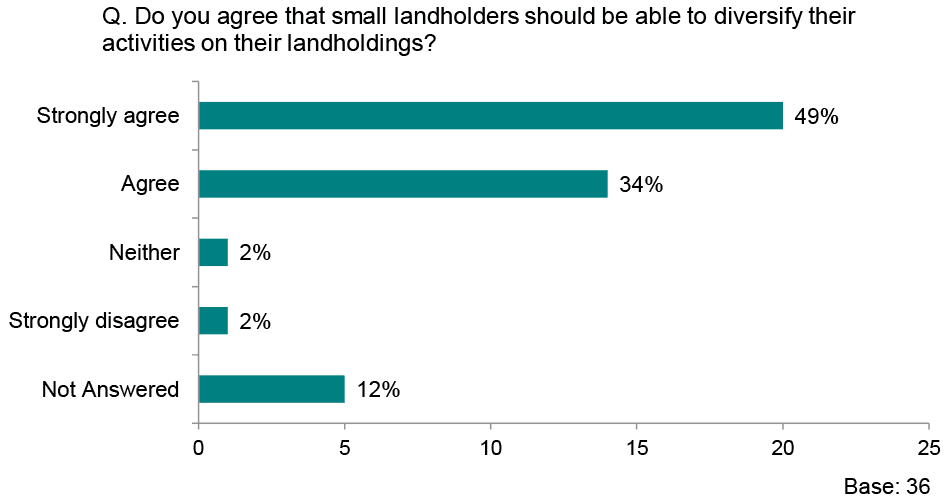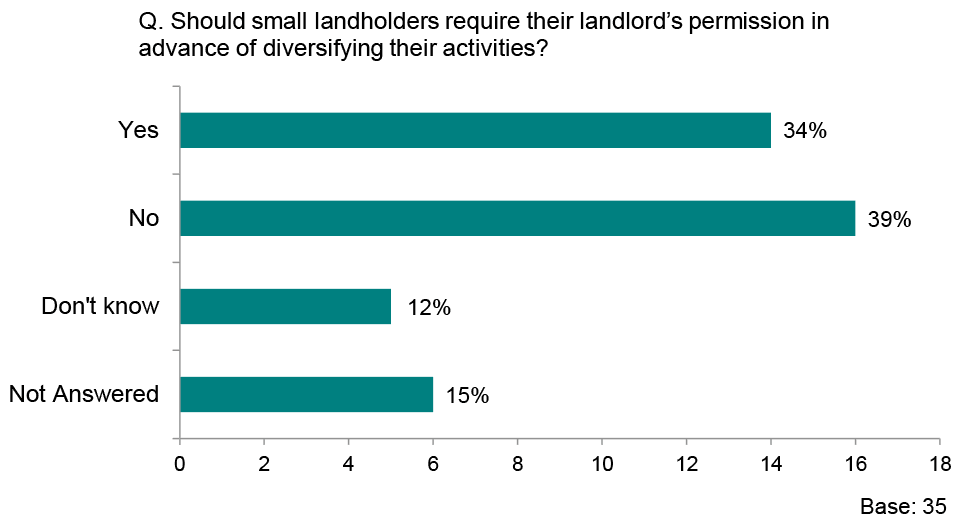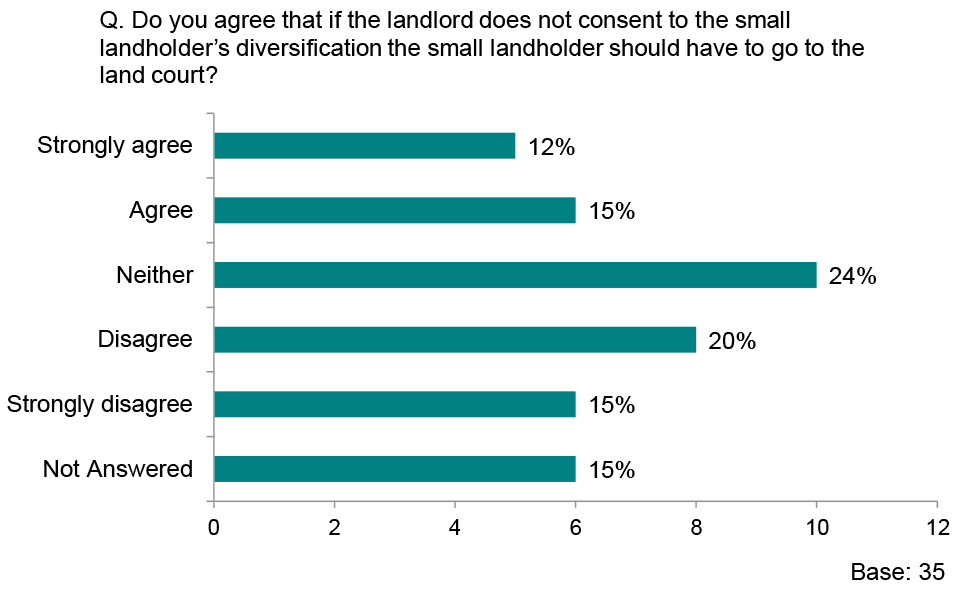Small landholdings modernisation: consultation analysis
This report outlines the results of a consultation held from October 2022 to January 2023. The consultation aimed to gather views on proposals to modernise and update small landholdings legislation.
2. Consultation findings: Diversification
This section of the report outlines the consultation findings in relation to the second set of questions on Diversification.
The Scottish Government proposes:
To introduce legislation to enable small landholders to diversify their current activities, and to modernise and adapt their business enterprise, in line with the options available to other tenants of agricultural land. This aims to allow small landholders to play their part in tackling the urgent climate and biodiversity crises.
This could be delivered by implementing a similar approach as has been used in the crofting legislation. This could help enable small landholdings to develop their business, and contribute more to their local community.
Key findings
The majority of respondents (83%) agreed that small landholders should be able to diversify their activities on their landholdings. Over a third of respondents (39%) stated that small landholders should not require their landlord’s permission in advance of diversifying their activities, whilst a slightly lower number said they should. Around a third of respondents (35%) did not agree that the small landholder should have to go to the land court if the landlord does not consent to their diversification, whilst just over a quarter (27%) agreed that they should.
This section of the report outlines the consultation findings in relation to the second set of questions on Diversification, which focused on:
- Small landholders’ ability to diversify their activities on their landholdings;
- Views on a requirement for landlord’s permission in advance of diversification;
- Views on role of the land court if the landlord does not consent to the small landholder’s diversification.
The results are set out separately for each question.
2.H Small landholders’ ability to diversify their activities on their landholdings

| Option | Total | Percent |
|---|---|---|
| Strongly agree | 20 | 48.78% |
| Agree | 14 | 34.15% |
| Neither | 1 | 2.44% |
| Disagree | 0 | 0.00% |
| Strongly disagree | 1 | 2.44% |
| Not Answered | 5 | 12.20% |
The majority of respondents (83%) agreed that small landholders should be able to diversify their activities on their landholdings. Only 2% disagreed and the same number (2%) said ‘Neither’. Around a tenth of respondents (12%) did not answer.
Respondents were asked to give reasons for their answer, and a total of 30 did so.
Key findings
The majority of respondents (83%) agreed that small landholders should be able to diversify their activities on their landholdings.
Respondents who agreed that small landholders should be able to diversify their activities on their landholdings gave reasons including: potential benefits for rural communities and small landholders’ ability to take advantage of new financial opportunities, from climate change mitigation to tourism.
A number of respondents felt that diversification is key to the economic sustainability of small landholdings, tenants’ businesses and the agricultural sector more widely. Several respondents felt that diversification should not be limited to activities to tackle the climate crisis, and that small landholders should be able to carry out a range of activities to encourage future innovation.
Respondents who agreed that small landholders should be able to diversify their activities on their landholdings gave a number of reasons, including:
- potential benefits for rural communities, such as the creation of jobs;
- small landholders’ ability to take advantage of new opportunities, from climate change mitigation to tourism, such as self-catering accommodation;
- small landholders should have equal rights to diversify their activities as other types of agricultural tenants;
- this would be in line with the Scottish Government's wider rural policy, for example its support for rural businesses.
A number of respondents stated that diversification on small landholdings should be done in line with crofting legislation, and the requirements made of crofters, for example that diversification is for a 'purposeful use'. One noted that any future changes to crofting legislation should be reflected in small landholding legislation.
In contrast, one organisation stated that legislation to enable small landholders to diversify their current activities should be done in line with provisions made within the 1991 Act, including the structure of notices, timetables and criteria for landlords’ consent, and in line with any planned changes to this legislation.
A number of respondents felt that diversification is key to the economic sustainability of small landholdings, their tenants’ businesses and the agricultural sector more widely. Several felt this was particularly the case in the context of changing agricultural support payments, and that the need to have additional sources of income can be seen in other contexts such as crofting, with one stating that small-scale farmers do not qualify for enough support.
As one individual noted:
Diversification of activities will become increasingly important as government policy refocuses towards environmental and climate change mitigation measures and as farmers and crofters look towards other sources of income.
Several respondents noted that diversification should be done by mutual agreement with the landlord, who should have a right to object, for example if the planned activity would devalue the holding. One respondent highlighted a need for negotiation, and the potential for conflicts of interest between the landlord and tenant, for example in long-term land-use change. Others felt there should be safeguards, as in crofting law, to ensure the suitability of planned diversification activities. Examples given by respondents in terms of suitability included:
- should be suitable in terms of the land and its agricultural use;
- should not be detrimental to local residents or the environment;
- should be for environmental or tourism purposes.
Several respondents felt that diversification should not be limited to activities to tackle the climate crisis, and that small landholders should be able to carry out a range of new activities to encourage future innovation. As one stated, a broader range of opportunities should be promoted in line with the proposals set out in the Scottish Government’s Agriculture Bill consultation.
2.I Requirement for landlord’s permission in advance of diversification

| Option | Total | Percent |
|---|---|---|
| Yes | 14 | 34.15% |
| No | 16 | 39.02% |
| Don’t know | 5 | 12.20% |
| Not Answered | 6 | 14.63% |
Over a third (39%) of respondents stated that small landholders should not require their landlord’s permission in advance of diversifying their activities, whilst a slightly lower number (34%) said they should. Just over a tenth (12%) said ‘Don’t know’.
Key findings
Over a third of respondents (39%) stated that small landholders should not require their landlord’s permission in advance of diversifying their activities, whilst a slightly lower number said they should.
In terms of whether that permission should have a set timescale that a landlord is required to meet, one set of respondents felt that small landholders should not be required to ask their landlord's permission or follow a timescale, as they should be able to diversify and make improvements to the land as needed. Several others felt that permission should not be required, but that small landholders should inform the landlord of their intention to diversify.
Another set of respondents, including a number of organisations, felt that gaining the landlord's permission and making use of a timescale was appropriate, for example where diversification would result in a long-term change in land use. Respondents also felt that a timescale was important in order to progress with the proposed activity.
Around half of those who responded to this question gave their views on a potential timescale. Suggestions varied, and included: 28 days, in line with the crofting framework; 3 months; permission in principle within 6 weeks with full permission granted or refused within 6 months; the same but within a 12 month timescale.
If yes, should that permission have a set timescale that a landlord is required to meet?
A total of 26 responses were received to this follow-up question. Individual respondents felt this should depend on the type of diversification, or should be subject to planning permission.
One set of respondents felt that small landholders should not be required to ask their landlord's permission or follow a timescale, as they should be able to diversify and make improvements to the land as needed.
Several others felt that permission should not be required, but that small landholders should inform the landlord of their intention to diversify, and that whilst the landlord should not be able to prevent diversification they should have some form of recourse. One individual stated that permission should only be needed in the event of a material change, for example that requires planning permission.
A further set of respondents, including a number of organisations, felt that gaining the landlord's permission and making use of a timescale was appropriate, for example where diversification would result in a long-term change in land use or could have financial impacts on the land owner. One organisation highlighted a need for clarity in terms of what types of diversification are possible.
One attendee at the public consultation event in Arran highlighted a need for clarity in terms of what is classed as diversification, and stated that if a lease is for agricultural purposes it should remain the same and if small landholders want to do something else then it should be a commercial lease.
Several stated that there should be a requirement for dialogue between the landlord and tenant, and a mechanism to deal with any landlord's refusal to allow a proposed diversification. As one respondent stated, agreements between landlords and their tenants to enable diversification, for example as a joint venture, can often be reached informally and legislation may not be appropriate in this context.
Around half of those who responded to this question gave their views on a potential timescale. Again, several respondents felt that this should be in line with crofting regulation whilst others stated that it should be consistent with other forms of agricultural tenancies. Specific timescales suggested by respondents included:
- 28 days, in line with the crofting framework;
- Permission should be restricted to simple notification with one month to raise objections;
- 3 months;
- permission in principle within 6 weeks with full permission granted or refused within 6 months - to allow the small landholder time to secure other approvals as needed;
- initial response within 12 weeks of the tenant expressing a written interest to the landlord or his agents, and permission or refusal within 12 months.
Respondents felt that a timescale was important in order to progress with the proposed activity, with one stating that failure by the landlord to engage with the tenant during this period should be deemed agreement by default. Others agreed that there should be a timescale for landlords to respond, once they have received the information they require to make a decision.
2.J Views on role of the land court if the landlord does not consent to the small landholder’s diversification

| Option | Total | Percent |
|---|---|---|
| Strongly agree | 5 | 12.20% |
| Agree | 6 | 14.63% |
| Neither | 10 | 24.39% |
| Disagree | 8 | 19.51% |
| Strongly disagree | 6 | 14.63% |
| Not Answered | 6 | 14.63% |
Around a third of respondents (35%) did not agree that the small landholder should have to go to the land court if the landlord does not consent to their diversification. Just over a quarter (27%) agreed that they should, whilst a quarter (24%) said ‘neither’ and 15% of respondents did not answer the question.
Key findings
Around a third of respondents (35%) did not agree that the small landholder should have to go to the land court if the landlord does not consent to their diversification, whilst just over a quarter (27%) agreed that they should.
For those who agreed, several felt this was a necessary step, and that the land court was an appropriate forum. For those who disagreed, reasons given included the fact that this depend on the proposed activity. One group of respondents raised concerns about the costs, inconvenience and risks of going to the land court for small landholders.
Alternative options suggested by respondents included: alternative methods of dispute resolution, such as dialogue or mediation; bringing small landholdings into line with crofting, or other types of agricultural tenancies; agreeing a list of acceptable diversifications instead; finding a more affordable, local option for small landholders; use of the planning process or another public body.
If you disagree what alternative do you propose?
A total of 27 responses were received to this follow-up question, from those who both agreed or disagreed that the small landholder should have to go to the land court if the landlord does not consent to their diversification.
Alternatives suggested by respondents can be summarised as follows:
- alternative methods of dispute resolution should be used, such as dialogue or mediation as part of a stepped process, with the land court as last resort;
- this issue should be brought in line with crofting, or alternatively with other types of agricultural holdings;
- a list of acceptable diversifications should be agreed instead;
- a more affordable, local option for small landholders should be found, for example a public body;
- landlords should have to go to the land court;
- use of the planning permission process;
- the Tenant Farming Commissioner should be used;
- support from the Scottish Land Commission.
For those who agreed, several felt this was a necessary step, and that the land court was an appropriate forum. Several stated that the majority of cases can be resolved by reaching an agreement, and that the Land Court should be used as a last resort. Others felt this issue would be resolved by the granting or denial of planning permission, as used by crofting trusts.
Several respondents stated that this issue should be brought in line with crofting, and that the Crofting Commission would be a more accessible and suitable body, and that in this case, the Scottish Crofting Federation would be able to support the tenant during this process. One respondent stated that it would not be fair to provide small landholders with more diversification rights than crofters. Others stated that the issue of diversification on small landholdings should be in line with other types of agricultural holdings more generally.
Several respondents felt that both parties should be encouraged to use alternative methods of dispute resolution, and that there should be provision for this. One organisation stated that dialogue and engagement should be encouraged to try and address issues before going to the land court, as part of a stepped process. As another organisation stated, alternative methods can be a quicker and more cost-effective way of handling disputes.
For those who disagreed, a range of reasons were given, including the view that landlords not tenants should be obliged to go to the land court, or that this option would depend on the proposed activity. One suggested that a list of acceptable diversifications should be agreed.
One group of respondents raised concerns about the costs, inconvenience and risks of going to the land court for small landholders. One suggested that this may prevent them going ahead with their diversification plans, whilst others felt that a more affordable, local option should be available and that tenants would benefit from having access to a more approachable public body.
As one organisation highlighted, going to the land court may have a negative impact on tenant and landowner relationships. The use of a fair process and timescale as suggested above should provide the basis of any necessary arbitration, with a mutually agreed or independently appointed arbiter, as an alternative approach.
Several organisations suggested that it would be appropriate for small landholders to go to the Scottish Land Commission if their landlord does not consent, for example to ask them to appoint an expert to resolve the dispute. Whilst some respondents felt that landlords should have the final say, others felt that landlords should not be able to prevent changes in land use, or should only be able to object to tenants' diversification plans if they had valid reasons.
Contact
There is a problem
Thanks for your feedback